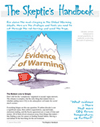|
|
Fans of man-made global warming frequently tell us seas are rising, but somehow forget to mention the rise started 200 years ago, long before our coal-fired electricity plants cranked up, and long before anyone had an electric shaver, or a 6 cylinder fossil-fuel-spewing engine. Something else was driving that warming trend.
Here is the data from tide gauges going back 300 years from a paper by Jevrejeva et al 2008.
[Graphed by Joanne Nova based on data from Jevrejura et al located at this site PMSML]
This graph was calculated from 1023 tide gauge records [Jevrejeva et al., 2006] going back to 1850.The 2008 study extended the record further using three of the longest (though discontinuous) tide gauge records available: Amsterdam, since 1700 [Van Veen, 1945], Liverpool, since 1768 [Woodworth, 1999] and Stockholm, since 1774 [Ekman, 1988]. Obviously since there are only three old records, the error bars are a riot.
The Jevrejeva paper is also useful for portraying the 60 year rolling cycle. The regular ups and downs are obvious when the rate of change is plotted (see below).
7.5 out of 10 based on 20 ratings […]
It’s worse than we thought. The models I mean — they are more hopeless at predicting things like regional sea-level rise than we had reckoned, and we thought they were god-awful.
Remember the awe-inspiring, grant-inducing and legislation-bending Victorian report suggesting “up to 45,000 Victorian homes – worth $10.3 billion – face inundation….Across Australia 247,600 individual buildings valued at $63 billion could be damaged or lost, while major infrastructure, including Sydney and Brisbane airports, are at risk of being flooded by increasingly damaging storms.” (The airports, forgoodnesssake, were going to be underwater, and the 737’s would need those optional float thingies to “land” where there wasn’t much … land.)
Then the poor residents of Port Albert were told to build houses on stilts to avoid the feared sea-level rise (and in a double dose of bureaucratic jeopardy: at the same time they had to keep their roof-tops below the “heritage” line — making houses fit for pygmies).
Those Hollywood-style-apocalyptic flood results are based on an estimated “1.1-metre sea level rise by 2100”. Let’s think that through: current sea level is rising roughly 2mm – 3mm a year, and thus, to hit that 1.1 metre total by 2100 those global seas will […]
Just in case you missed it, there has been yet another example of data manipulation in the endless round of adjustments that bring reality closer to the models. Thanks to James Taylor in Climate Change Weekly for drawing our attention to it.
Sea levels are one of the top five most critical measurements to tell us about the planet’s “heat”. Remember, they say “it’s worse than we thought” and that sea level rise is accelerating. Yet the measurements by the best equipment available — satellites — tell of a steady linear rise of just 3mm year after year, except for lately, when it’s been lower. (What kind of scientist can’t predict where a straight line is headed?)
Sea level is hard to measure — the sea is not flat — the ground also moves, but satellites measure the world’s oceans every ten days to an accuracy of several millimeters, and what’s more, they measure it compared to the center of the Earth (see below). NASA says so. So it is hard to explain why, after delaying the latest (shrinking) results for a couple of months past the usual posting date, they now announce that they’ve added “a correction of 0.3 […]
SOURCE: Semi-Satirical News
Preschooler outdoes climate models
Back in 2001, little Alby Brushtail was just 4 when he predicted global sea levels for a decade by drawing a straight line through a graph. Today, Will Steffen, Director of the Climate Institute admits that global climate models are woeful at predicting sea levels in a story titled: “Sea levels rising at top end of estimates”.
The failure of the sophisticated models is all the more baffling because by 2001, global sea levels had been rising at the not-so-tricky, fairly steady rate of 3mm a year for the previous nine years. Despite this simple linear trend, even with the worlds best equipment and budgets of millions, the top experts only barely managed to predict future sea levels within their broad error margins.
In the end, they couldn’t outdo the four year old who drew the line in with an orange crayon in his preschool class and who simply said that the 3mm a year trend would “just keep going”.
For his remarkable success in 2001, Alby credited Mr Squiggle, but says he’s moved on now, and uses a […]
Are the small islands of the South Pacific in danger of disappearing, glug, under the waves of the rising ocean? Will thousands of poor inhabitants be forced to emigrate, as desperate refugees, to Australia and New Zealand? Has any of this got anything to do with man-made emissions of CO2?
By looking closely at the records, it turns out that the much advertised rising sea levels in the South Pacific depend on anomalous depressions of the ocean during 1997 and 1998 thanks to an El Nino and two tropical cyclones. The Science and Public Policy Institute has released a report by Vincent Gray which compares 12 Pacific Island records and shows that in many cases it’s these anomalies that set the trends… and if the anomaly is removed, sea levels appear to be more or less constant since the Seaframe measurements began around 1993.
Sea levels: The El Nino / tropical storm anomaly in 1997-1998 is clear. A long sustained rise is not.
Take the infamous Tuvalu for example. It’s sea level rise was reported as 5.7 mm/year back in 2008. Now it’s calculated as 3.7mm/year. But look at the Seaframe Graph – its flat. It is universally forecast […]
Dr Andrew Glikson (an Earth and paleoclimate scientist, at the Australian National University) contacted Quadrant offering to write about the evidence for man-made global warming. Quadrant approached me asking for my response. Dr Glikson replied to my reply, and I replied again to him (copied below). No money exchanged hands, but Dr Glikson is, I presume, writing in an employed capacity, while I write pro bono. Why is it that the unpaid self taught commentator needs to point out the evidence he doesn’t seem to be aware of? Why does a PhD need to be reminded of basic scientific principles (like, don’t argue from authority). Such is the vacuum of funding for other theories that a debate that ought to happen inside the university obviously hasn’t occurred. Such is the decrepit, anaemic state of university science that even a doctorate doesn’t guarantee a scientist can reason. Where is the rigor in the training, and the discipline in the analysis?
Credibility lies on evidence
by Joanne Nova
April 29, 2010
Reply to Andrew Glikson
Dr Andrew Glikson still misses the point, and backs his arguments with weak evidence and logical errors. Instead of empirical evidence, often […]
Dr Andrew Glikson writes for Quadrant and I respond .
This is a copy. It begs the question. Dr Glikson, is an Earth and paleo-climate scientist at the Australian National University. He’s paid to give us both sides of the story.
No, Dr Glikson
by Joanne Nova
April 19, 2010
Dr Andrew Glikson says the right motherhood lines [see: Case for Climate Change]: he talks about empirical evidence, and wants evidence based policies. All this is good, yet he sidesteps the main point — what exactly is the evidence for the theory of man-made global warming? It’s the only point that matters, yet when he presents evidence it’s either not empirical, not up to date, or not relevant. Why?
By hitting all the right key phrases a reader might accidentally think that Glikson is presenting key evidence and good reasoning. Take this for example: Glikson fears we’re turning away from evidence-based policies. (Me too!) But to complete the sentence he lists all the committees who predict bad weather 90 years from now. It makes for good PR, but is not scientific evidence.
Committee reports count as “evidence” in a court of law, but in science, certificates, declarations, contracts, commission […]
|
JoNova A science presenter, writer, speaker & former TV host; author of The Skeptic's Handbook (over 200,000 copies distributed & available in 15 languages).

Jo appreciates your support to help her keep doing what she does. This blog is funded by donations. Thanks!


 Follow Jo's Tweets
Follow Jo's Tweets To report "lost" comments or defamatory and offensive remarks, email the moderators at: support.jonova AT proton.me
Statistics
The nerds have the numbers on precious metals investments on the ASX
|












Recent Comments